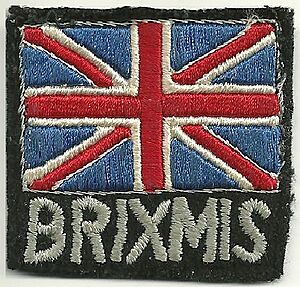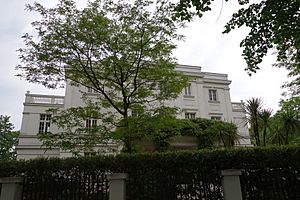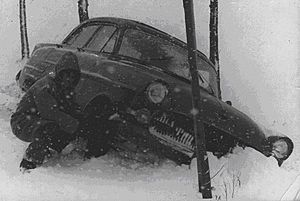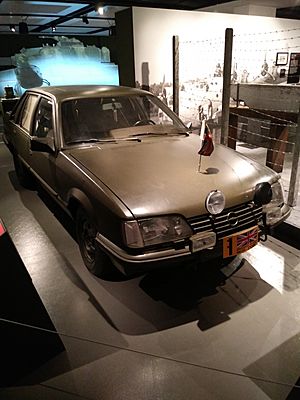BRIXMIS facts for kids
The British Commanders'-in-Chief Mission to the Soviet Forces in Germany (BRIXMIS) was a special military team. It worked behind the Iron Curtain in East Germany during the Cold War.
BRIXMIS started in 1946, soon after World War II ended. It continued until 1990, just before Germany became one country again. The main goal of BRIXMIS, and a similar Soviet team called SOXMIS, was to help the military leaders in charge of the different parts of Germany talk to each other.
Each team had 31 members. These included 11 officers and up to 20 other staff. They had special passes that let them travel freely in the other side's zone. They wore uniforms and drove easily seen vehicles. These trips were called "tours." Even though it wasn't said openly, these tours were also a great chance to gather military information. This included looking for new equipment and watching troop movements. Both sides used this chance fully.
BRIXMIS was in a perfect spot to understand what the Soviet Union was planning. It was behind the Iron Curtain. Also, it was an important way for West and East to communicate. This was the main reason it was set up.
Contents
A Look Back: BRIXMIS History
After World War II, the Allied countries divided Germany into four zones. It quickly became clear that they needed a way to talk to each other. This was especially true for the Western Allies and the Soviet Union. Exchanging military teams seemed like a good idea.
The first agreement was between the British and Soviet zones. It was called the Robertson-Malinin Agreement. This deal was made on September 16, 1946. Later, in 1947, similar teams were set up between the Soviet zone and the French and US zones. The British-Soviet team was much larger. It allowed 31 people on each side to have special passes.
The British team included members from the British Army, Royal Navy, and Royal Air Force. They did their liaison work in uniforms and marked cars. They also used two small planes called Chipmunks. These planes helped the aircrew stay skilled at flying.
BRIXMIS had a main office in Potsdam, East Germany. This was called the Mission House. But its real headquarters and operations center were in West Berlin. These were located in the London Block, part of the Olympic Stadium complex. This area also housed the British military government for Berlin. The first Mission House in Potsdam was damaged in 1958. The Soviet authorities then provided a new one. It was at 34 Seestrasse, near the Glienicke Bridge. They also paid for the damage.
The fall of the Berlin Wall in 1989 was a huge event. But it mostly brought things back to how they were before the wall was built in 1961. The need for talking and gathering information was still important. So, the agreements stayed in place until October 2, 1990. All three agreements were stopped just before Germany became one country.
BRIXMIS officially closed on December 31, 1990. However, a few staff members stayed. They continued similar work secretly for the next three years. They no longer had the special protection of the agreement. This "son-of-BRIXMIS" unit existed because the West wasn't sure if the Soviet Union would fully leave the now united Germany.
How BRIXMIS Teams Connected
Most official connections happened at formal events. These included parades for the Queen's birthday and parties at the Mission House. There was also a Remembrance Day religious service. This service took place at the Stahnsdorf War Graves cemetery, south of Berlin. The teams also regularly visited British memorials at former concentration camps. These included Buchenwald, Sachsenhausen, and Ravensbrück.
Informal contact happened at parties. These were often for special events. Members of the Soviet External Relations Branch (SERB) were also invited to these parties.
Mission members with a full "touring" pass could also go on "cultural tours." On these trips, team members and their families could stay in hotels in major East German cities. These trips were great chances to meet Soviet and East German military members and civilians. They might not have met these people during their normal duties.
Gathering Important Information
The agreement allowed BRIXMIS staff to travel almost anywhere in the other zone. Only a few areas were always off-limits. Other areas could be temporarily restricted. There were rules for telling the missions when these temporary restrictions were in place.
The teams mostly followed these rules. But there were also many "Missions prohibited" signs near military places that were not officially announced. The teams often ignored these signs. Sometimes, they even took them home as souvenirs! If a team was caught in a forbidden area, they were usually chased. If caught, they were arrested and held for a short time. The biggest risk for those who often broke the rules was being declared persona non grata. This meant their passes would be taken away. This would waste all their special training for BRIXMIS.
This freedom to move around East Germany helped BRIXMIS gather information. They learned about Warsaw Pact forces, especially from the Soviet Union and East Germany. This included where troops were, how they moved, what equipment they had, and their training. Each team had a tour officer, a tour NCO, and a driver. In later years, they all received similar training.
Their ground tours were done in cars. They explored areas on their own or as told by Defence Intelligence in London. These tours could last several days. The teams were self-sufficient. They cooked their own meals and slept in the countryside. The driver always slept in the vehicle. The other two usually slept in bivouacs or small tents. Once they left Potsdam, they had no contact with their headquarters. They had to deal with any problems or opportunities on their own.
It was rare for teams to face open hostility. This included being physically attacked, shot at, or having their vehicle rammed. But these things did happen sometimes. What was very common, though, was being followed by "narks." These were members of the East German State Security Service (Stasi). BRIXMIS teams had better equipment, driving skills, and knew the local areas very well. This usually meant they could get away from the "narks."
The British Mission was mostly open. All staff wore uniforms and drove marked vehicles. However, sometimes the officer and NCO would leave the driver in the car and explore on foot. They would try to hide any signs of their military identity. The Soviet Mission in the British zone was more secret. They also had ways to handle secret agents.
BRIXMIS was known for many clever ways of getting technical information. Some examples include:
- Secretly bringing parts of a Yak-28P Firebar jet back to Farnborough. This included its radar and jet engines. The plane had crashed into a lake in Berlin.
- Measuring the size of the 30mm gun on a new BMP-2 armoured personnel carrier. They did this by pressing an apple into the gun barrel to get an impression.
- Stealing reactive armour from a Russian tank to study it.
Vehicles Used by BRIXMIS
In the 1950s, BRIXMIS used Opel Kapitän cars. Later, they used Opel Admiral cars and then the Opel Senator. These cars were changed in the UK to have four-wheel drive. But the teams needed vehicles that could drive better off-road. So, they got several special Range Rovers. These were expensive to run and fix in Germany.
Because of this, they tested a single Mercedes-Benz G-Class in 1980–81. After testing it a lot, they chose the G-Wagen as their main tour vehicle. Different models of the G-Wagen were used until BRIXMIS stopped operations in 1990. You can see an old BRIXMIS G-Wagen at the Military Intelligence Museum in Chicksands, England.
BRIXMIS also used British legal rights under the Potsdam Agreement. This allowed them to use the airspace over both West and East Berlin. They could also use the air corridors to and from West Germany to the city. Two de Havilland Chipmunk T10 planes were based at RAF Gatow. RAF aircrew working for BRIXMIS used these planes. They flew photographic reconnaissance flights within a 12-nautical-mile circle around the Berlin Air Safety Centre in West Berlin.
After the Berlin Wall fell, Chipmunk flights stopped. The two Chipmunks were flown to RAF Laarbruch in West Germany. They waited there to be given away. Chipmunk WB466 was flown back to Berlin. It was given to the Allied Museum in Berlin, where it is still on display. WG486 is still used by the RAF with the Battle of Britain Memorial Flight.







